Impacts of Radar Data Assimilation on the Forecast of “12.8” Extreme Rainstorm in Central China (2021)
Abstract
:1. Introduction
2. Methods
2.1. Hydrometeor Concentration Retrieval Method
2.2. Water Vapor Content Retrieval Method
2.3. Quality Control of Radar Data
3. Case Selection and Diagnostic Analysis
3.1. Overview of the Rainstorm Process
3.2. Circulation Situation and Influence System
4. Numerical Experiments and Simulation Results
4.1. Experiment Design
4.2. Simulation Results
4.2.1. Simulation for Composite Reflectivity
4.2.2. Precipitation Simulation
4.3. Simulation Results from RADAR-QV_C Experiment
4.3.1. Simulation for Composite Reflectivity
4.3.2. Precipitation Simulation
5. Conclusions and Discussion
Author Contributions
Funding
Institutional Review Board Statement
Informed Consent Statement
Data Availability Statement
Conflicts of Interest
References
- Barbero, R.; Fowler, H.J.; Lenderink, G.; Blenkinsop, S. Is the intensification of precipitation extremes with global warming better detected at hourly than daily resolutions? Geophys. Res. Lett. 2017, 44, 974–983. [Google Scholar] [CrossRef]
- Huang, X.; Wang, D.; Ziegler, A.D.; Liu, X.; Zeng, H.; Xu, Z.; Zeng, Z. Influence of urbanization on hourly extreme precipitation over China. Environ. Res. Lett. 2022, 17, 044010. [Google Scholar] [CrossRef]
- Zhang, X.; Xu, D.; Liu, R.; Shen, F. Impacts of FY-4A AGRI Radiance Data Assimilation on the Forecast of the Super Typhoon “In-Fa” (2021). Remote Sens. 2022, 14, 4718. [Google Scholar] [CrossRef]
- Zhang, X.; Xu, D.; Li, X. Nonlinear Bias Correction of the FY-4A AGRI Infrared Radiance Data Based on the Random Forest. Remote Sens. 2023, 15, 1809. [Google Scholar] [CrossRef]
- Luo, L.; Xiao, H.; Yang, H.; Chen, H.; Guo, J.; Sun, Y.; Feng, L. Raindrop Size Distribution and Microphysical Characteristics of a Great Rainstorm in 2016 in Beijing, China. Atmos. Res. 2020, 239, 104895. [Google Scholar] [CrossRef]
- Errico, R.M.; Bauer, P.; Mahfouf, J.F. Issues Regarding the Assimilation of Cloud and Precipitation Data. J. Atmos. Sci. 2007, 64, 3785–3798. [Google Scholar] [CrossRef]
- Chen, Y.; Wang, H.; Min, J.; Huang, X.Y.; Minnis, P.; Zhang, R.; Haggerty, J.; Palikonda, R. Variational Assimilation of Cloud Liquid/Ice Water Path and Its Impact on NWP. J. Appl. Meteorol. Climatol. 2015, 54, 1809–1825. [Google Scholar] [CrossRef]
- Shen, F.; Min, J.; Xu, D. Assimilation of radar radial velocity data with the WRF Hybrid ETKF—3DVAR system for the prediction of Hurricane Ike (2008). Atmos. Res. 2016, 169, 127–138. [Google Scholar] [CrossRef]
- Shen, F.; Xue, M.; Min, J. A comparison of limited-area 3DVAR and ETKF-En3DVAR data assimilation using radar observations at convective scale for the prediction of Typhoon Saomai (2006). Meteorol. Appl. 2017, 24, 628–641. [Google Scholar] [CrossRef]
- Shen, F.; Xu, D.; Hong, L.; Liu, R. Impact of radar data assimilation on a squall line over the Yangtze-Huaihe River Basin with a radar reflectivity operator accounting for ice-phase hydrometeors. Meteorol. Appl. 2021, 28, e1967. [Google Scholar] [CrossRef]
- Xu, D.; Liu, Z.; Fan, S.; Chen, M.; Shen, F. Assimilating all-sky infrared radiances from Himawari-8 using the 3DVar method for the prediction of a severe storm over North China. Adv. Atmos. Sci. 2021, 38, 661–676. [Google Scholar] [CrossRef]
- Xu, D.; Zhang, X.; Liu, Z.; Shen, F. All-sky infrared radiance data assimilation of FY-4A AGRI with different physical parameterizations for the prediction of an extremely heavy rainfall event. Atmos. Res. 2023, 293, 106898. [Google Scholar] [CrossRef]
- Weckwerth, T.M.; Pettet, C.R.; Fabry, F.; Weckwerth, T.M.; Pettet, C.R.; Fabry, F.; Park, S.J.; LeMone, M.A.; Wilson, J.W. Radar Refractivity Retrieval: Validation and Application to Short-Term Forecasting. J. Appl. Meteorol. 2005, 44, 285–300. [Google Scholar] [CrossRef]
- Shen, F.; Xu, D.; Min, J.; Chu, Z.; Li, X. Assimilation of radar radial velocity data with the WRF Hybrid 4DEnVar system for the prediction of Hurricane Ike (2008). Atmos. Res. 2020, 234, 104771. [Google Scholar] [CrossRef]
- Shen, F.; Song, L.; Li, H.; He, Z.; Xu, D. Effects of different momentum control variables in radar data assimilation on the analysis and forecast of strong convective systems under the background of northeast cold vortex. Atmos. Res. 2022, 280, 106415. [Google Scholar] [CrossRef]
- Shen, F.; Song, L.; He, Z.; Xu, D.; Chen, J.; Huang, L. Impacts of adding hydrometeor control variables on the radar reflectivity data assimilation for the 6–8 August 2018 mesoscale convective system case. Atmos. Res. 2023, 295, 107012. [Google Scholar] [CrossRef]
- Song, L.; Shen, F.; Shao, C.; Shu, A.; Zhu, L. Impacts of 3DEnVar-Based FY-3D MWHS-2 Radiance Assimilation on Numerical Simulations of Landfalling Typhoon Ampil (2018). Remote Sens. 2022, 14, 6037. [Google Scholar] [CrossRef]
- Song, T.; Xu, D.; Shen, F.; Shu, A.; Song, L. Forecast and Analysis of a Rainstorm Case in East China Based on the Blown-Up Theory. Atmosphere 2023, 14, 1508. [Google Scholar] [CrossRef]
- Xu, D.; Yang, G.; Wu, Z.; Shen, F.; Li, H.; Zhai, D. Evaluate Radar Data Assimilation in Two Momentum Control Variables and the Effect on the Forecast of Southwest China Vortex Precipitation. Remote Sens. 2022, 14, 3460. [Google Scholar] [CrossRef]
- Sun, J.; Crook, N.A. Dynamical and microphysical retrieval from Doppler radar observations using a cloud model and its adjoint. part I: Model development and simulated data experiments. J. Atmos. Sci. 1997, 54, 1642–1661. [Google Scholar] [CrossRef]
- Gao, J.; Xue, M.; Shapiro, A.; Droegemeier, K.K. A variational method for the analysis for three-dimensional wind fields from two Doppler radars. Mon. Weather Rev. 1999, 127, 2128–2142. [Google Scholar] [CrossRef]
- Hu, M.; Xue, M.; Bratseth, K. 3DVAR and cloud analysis with WSR-88D level-II data for the prediction of the Fort Worfh, Texas, tornadic thunderstorms. Part I: Cloud analysis and its impact. Mon. Weather Rev. 2006, 134, 675–698. [Google Scholar] [CrossRef]
- Li, G.; Xu, Y.; Cheng, W.; Cheng, R.; Gu, C. Sensitivity test of Doppler radar data assimilation for a large rainstorm process. Torrential Rain Disasters 2009, 28, 97–103. [Google Scholar]
- Wan, Q.; Xue, J. Study on the variational assimilation technique for the retrieval of wind fields from Doppler radar data. Acta Meteor. Sin. 2006, 20, 1–19. [Google Scholar]
- Shu, A.; Shen, F.; Jiang, L.; Zhang, T.; Xu, D. Assimilation of Clear-sky FY-4A AGRI radiances within the WRFDA system for the prediction of a landfalling Typhoon Hagupit (2020). Atmos. Res. 2022, 283, 106556. [Google Scholar] [CrossRef]
- He, Z.; Wang, D.; Qiu, X.; Jiang, Y.; Li, H.; Shu, A. Application of radar data assimilation on convective precipitation forecasts based on water vapor retrieval. Meteorol. Atmos. Phys. 2021, 133, 1–19. [Google Scholar] [CrossRef]
- Tong, M.; Xue, M. Ensemble Kalman filter assimilation of Doppler radar data with a compressible nonhydrostatic model: OSS experiments. Mon. Weather Rea. 2005, 133, 1789–1807. [Google Scholar] [CrossRef]
- Dowell, D.C.; Wicker, L.J.; Snyder, C. Ensemble Kalman filter assimilation of radar observations of the 8 May 2003 Oklahoma City supercell: Influences of reflectivity observations on storm scale analyses. Mon. Weather Rev. 2011, 139, 272–294. [Google Scholar] [CrossRef]
- Zhang, F.; Weng, Y.; Sippel, J.A.; Meng, Z.; Bishop, C.H. Cloud-Resolving Hurricane Initialization and Prediction through Assimilation of Doppler Radar Observations with an Ensemble Kalman Filter. Trop. Cyclone Predict. 2009, 137, 2105–2125. [Google Scholar] [CrossRef]
- Lin, Y.P.; Ray, P.S.; Johnson, K.W. Initialization of a model convective storm using Doppler radar derived fields. Mon. Weather Rev. 1993, 121, 2757–2775. [Google Scholar] [CrossRef]
- Takano, I.; Segam, I.A. Assimilation and initialization of a mesoscale model for improved spin-up of precipitation. Meteor. Soc. 1993, 71, 377–391. [Google Scholar] [CrossRef]
- Aonashi, K. An initialization method to incorporate precipitation data into a mesoscale numerical weather prediction model. Meteor. Soc. 1993, 71, 393–406. [Google Scholar] [CrossRef]
- Guo, X.; Dang, R.Q.; Ge, W.Z. The use of radar data in the numerical simulation of heavy rainfalls in the Changjiang-Huaihe River basin. J. Trop. Meteorol. 2000, 6, 212–218. [Google Scholar]
- Haase, G.; Grewell, S.; Simmer, C.; Wergen, W. Assimilation of radar data in mesoscale models: Physical initialization and latent heat nudging. Phys. Chem. Earth Part B 2003, 25, 1237–1242. [Google Scholar] [CrossRef]
- Li, Y.; Yuan, Z.; Wang, X. Adjustment of cloud microphysical variables in model atmospheres with Doppler radar reflectivity. J. Appl. Meteorol. Sci. 2004, 15, 658–664. [Google Scholar]
- Zhang, J.; Carr, F.; Brewster, K. ADAS Cloud Analysis. In Proceedings of the 12th Conference on Numerical Weather Prediction, Phoenix, AZ, USA, 11–16 January 1998; American Meteorological Society: Boston, MA, USA, 1998; pp. 185–188. [Google Scholar]
- Droegemeier, K.K. The advanced regional prediction system (ARPS), storm-scale numerical weather and data assimilation. Meteor. Atmos. Phys. 2003, 82, 139–170. [Google Scholar]
- Schenkman, A.D.; Xue, M.; Shapiro, A.; Brewster, K.; Gao, J. The Anlysis and Prediction of the 8–9 May 2007 Oklahoma Tornadic Mesoscale Convective System by Assimilating WSR-88D and CASA Radar Data Using 3DVAR. Mon. Weather Rev. 2011, 139, 224–246. [Google Scholar] [CrossRef]
- Cao, Q.; Zhang, G.; Xue, M. A Variational approach for retrieving raindrop size distribution from polarimetric radar measurements in the presence of attenuation. J. Appl. Meteorol. Climatol. 2013, 52, 169–185. [Google Scholar] [CrossRef]
- Huang, H.; Zhang, G.; Zhao, K.; Liu, S.; Wen, L.; Chen, G.; Yang, Z. Uncertainty in retrieving raindrop size distribution from polarimetric radar measurements. J. Atmos. Ocean. Technol. 2019, 36, 585–605. [Google Scholar] [CrossRef]
- Zhang, G.; Mahale, V.N.; Putnam, B.J.; Qi, Y.; Cao, Q.; Byrd, A.D.; Bukovcic, P.; Zrnic, D.S.; Gao, J.; Xue, M.; et al. Current status and future challenges of weather radar polarimetry: Bridging the gap between radar meteorology/hydrology/engineering and numerical weather prediction. Adv. Atmos. Sci. 2019, 36, 571–588. [Google Scholar] [CrossRef]
- Ryzhkov, A.V.; Zrnic, D.S. Discrimination between rain and snow with a polarimetric radar. J. Appl. Meteorol. 1998, 37, 1228–1240. [Google Scholar] [CrossRef]
- Vivekanandan, J.; Zrnic, D.S.; Ellis, S.M.; Oye, R.; Ryzhkov, A.V.; Straka, J. Cloud microphysics retrieval using S-band dual-polarization radar measurements. Bull. Am. Meteorol. Soc. 1999, 80, 381–388. [Google Scholar] [CrossRef]
- Jung, Y.; Zhang, G.; Xue, M. Assimilation of simulated polarimetric radar data for a convective storm using the ensemble Kalman filter. Part I: Observation operators for reflectivity and polarimetric variables. Mon. Weather Rev. 2008, 136, 2228–2245. [Google Scholar] [CrossRef]
- Jung, Y.; Xue, M.; Zhang, G.; Straka, J.M. Assimilation of simulated polarimetric radar data for a convective storm using the ensemble Kalman filter. Part II: Impact of polarimetric data on storm analysis. Mon. Weather Rev. 2008, 136, 2246–2260. [Google Scholar] [CrossRef]
- Li, X.; John, R.M.; Derek, P. An ice-phase microphysics forward model and preliminary results of polarimetric radar data assimilation. Mon. Weather Rev. 2017, 145, 683–708. [Google Scholar] [CrossRef]
- Kawabata, T.; Schwitalla, T.; Adachi, A.; Bauer, H.S.; Wulfmeyer, V.; Nagumo, N.; Yamauchi, H. Observational operators for dual polarimetric radars in variational data assimilation systems. Geosci. Model Dev. 2018, 11, 2493–2501. [Google Scholar] [CrossRef]
- Xiao, Y.; Wang, B.; Chen, X.; Cao, J.; Yang, X. Quality control of differential phase data from mobile X-band dual-line polarization Doppler weather radar. Plateau Meteorol. 2012, 31, 223–230. [Google Scholar]
- Lin, W.; Zhang, S.; Luo, C.; Jiang, H.; Xie, Z.; Li, D.; Chen, B. Analysis of S-band dual-polarization radar observations of strong convective cloud systems with different intensities. Meteorol. Mon. 2020, 46, 63–72. [Google Scholar]
- Yang, J.; Zheng, Y.; Xu, F. Analysis of two-line polarimetric radar observation of a hail process in Jianghuai region. Acta Meteorol. Sin. 2020, 78, 568–579. [Google Scholar]
- Wei, Q.; Hu, Z.; Liu, L.; Wu, L. C-band polarimetric radar data preprocessing and application in precipitation estimation. Plateau Meteorol. 2016, 35, 231–243. [Google Scholar]
- Chen, H.; Chandrasekar, V.; Bechini, R. An Improved Dual-Polarization Radar Rainfall Algorithm (DROPS2.0): Application in NASA IFloodS Field Campaign. J. Hydrometeorol. 2017, 18, 917–937. [Google Scholar] [CrossRef]
- Gao, J.; Stensrud, D.J. Assimilation of reflectivity data in a convective-scale, cycled 3DVAR framework with hydrometeor classification. J. Atmos. Sci. 2012, 69, 1054–1065. [Google Scholar] [CrossRef]
- Gao, S.; Sun, J.; Min, J.; Zhang, Y.; Ying, Z. A scheme to assimilate “no rain” observations from Doppler radar. Weather Forecast. 2018, 33, 71–88. [Google Scholar] [CrossRef]
- Zhang, Z.; Qi, Y.; Zhu, Z.; Li, D.; Zeng, Q.; Lan, H. Application of Shenzhen S-band and X-band dual-polarization radar in quantitative precipitation estimation. Acta Meteorol. Sin. 2021, 79, 786–803. [Google Scholar]
- Leng, L.; Huang, X.; Yang, H. Recognition and Application of Doppler Weather Radar Clear Air Echoes. Meteorol. Sci. Technol. 2012, 40, 534–541. [Google Scholar]



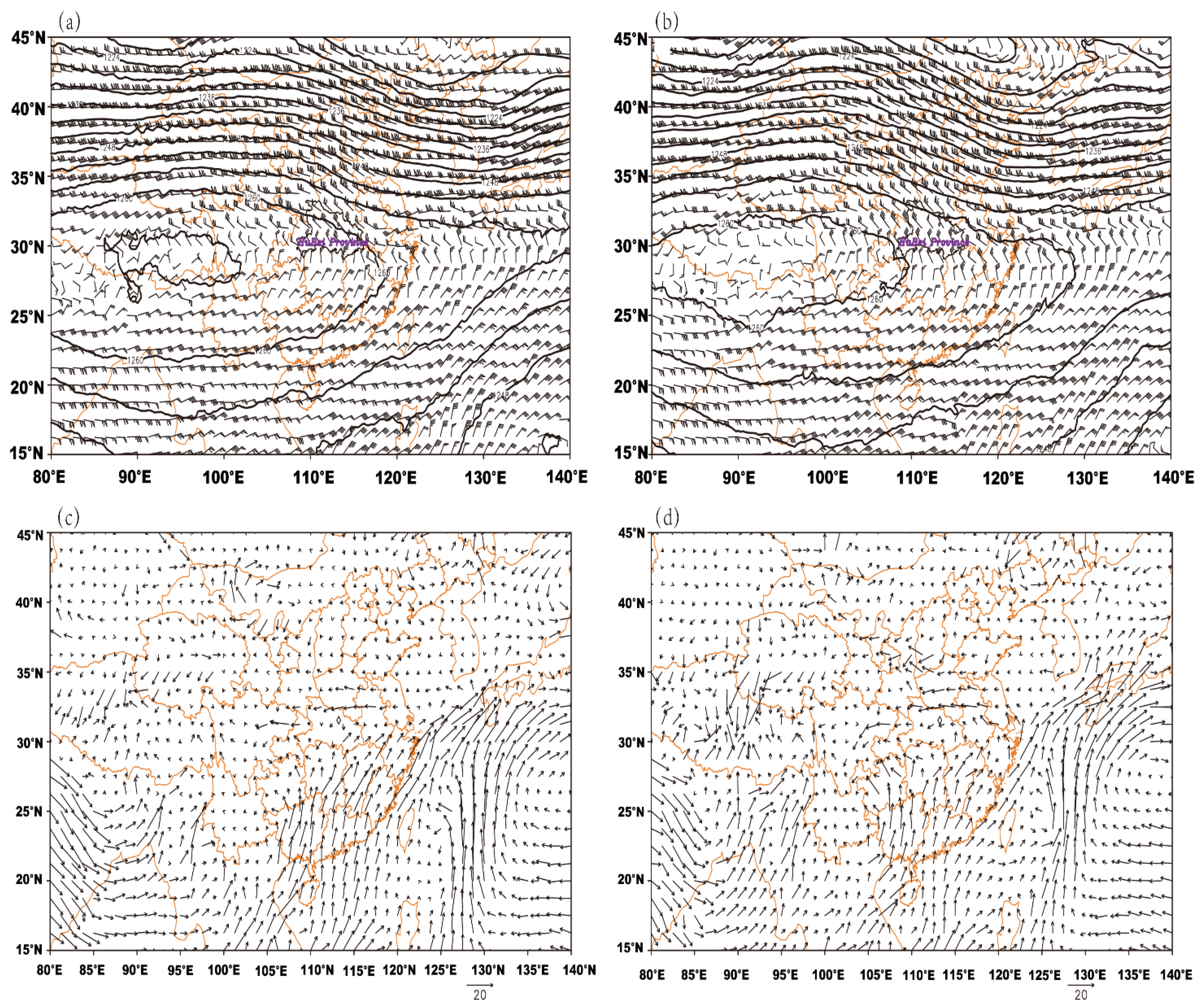
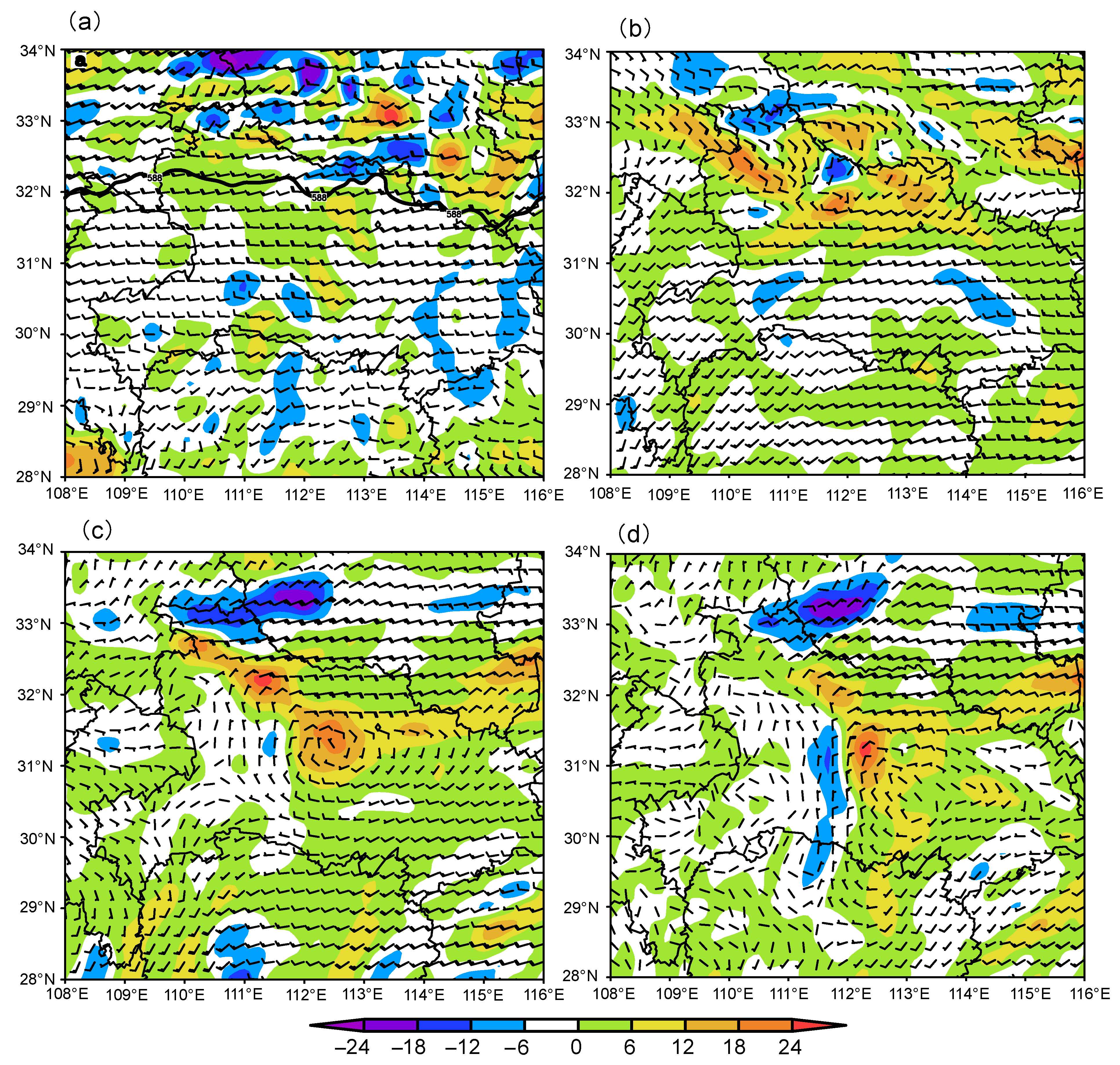
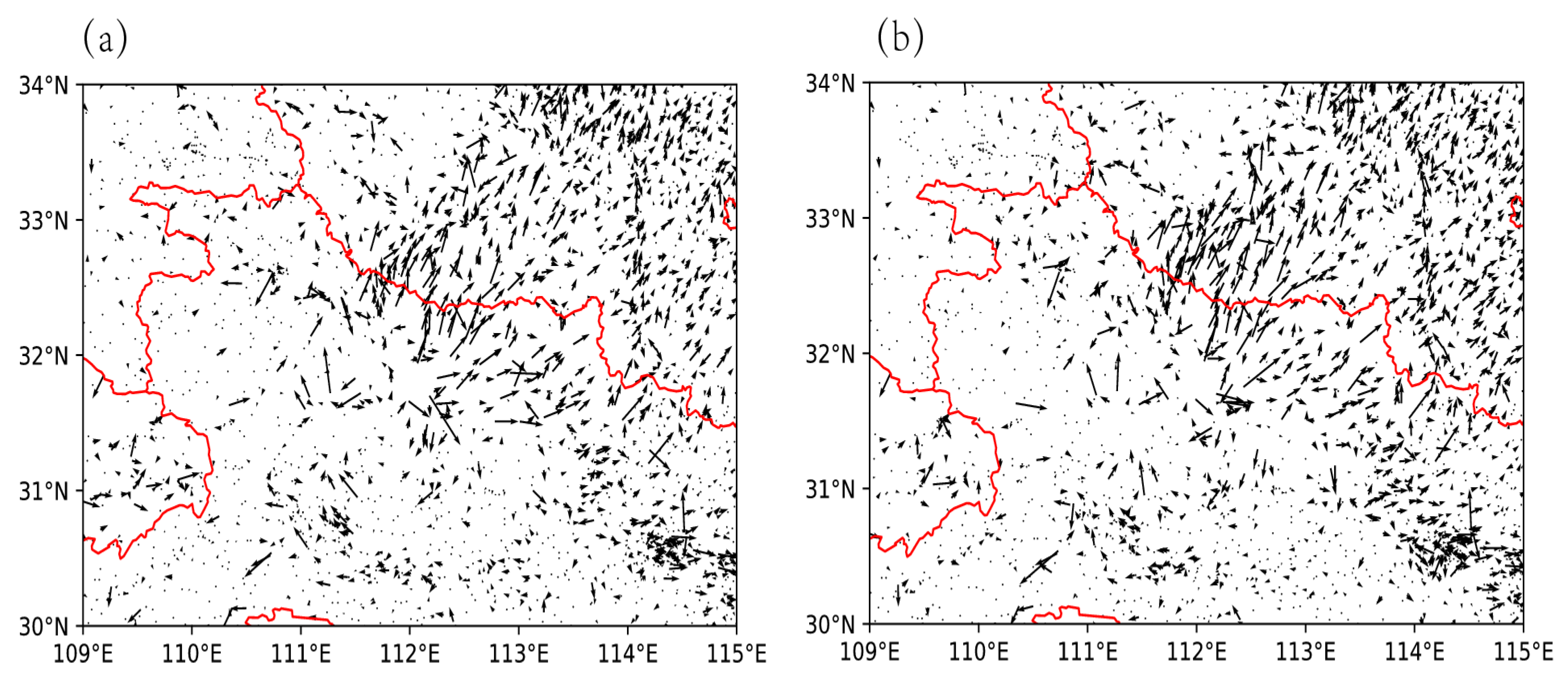

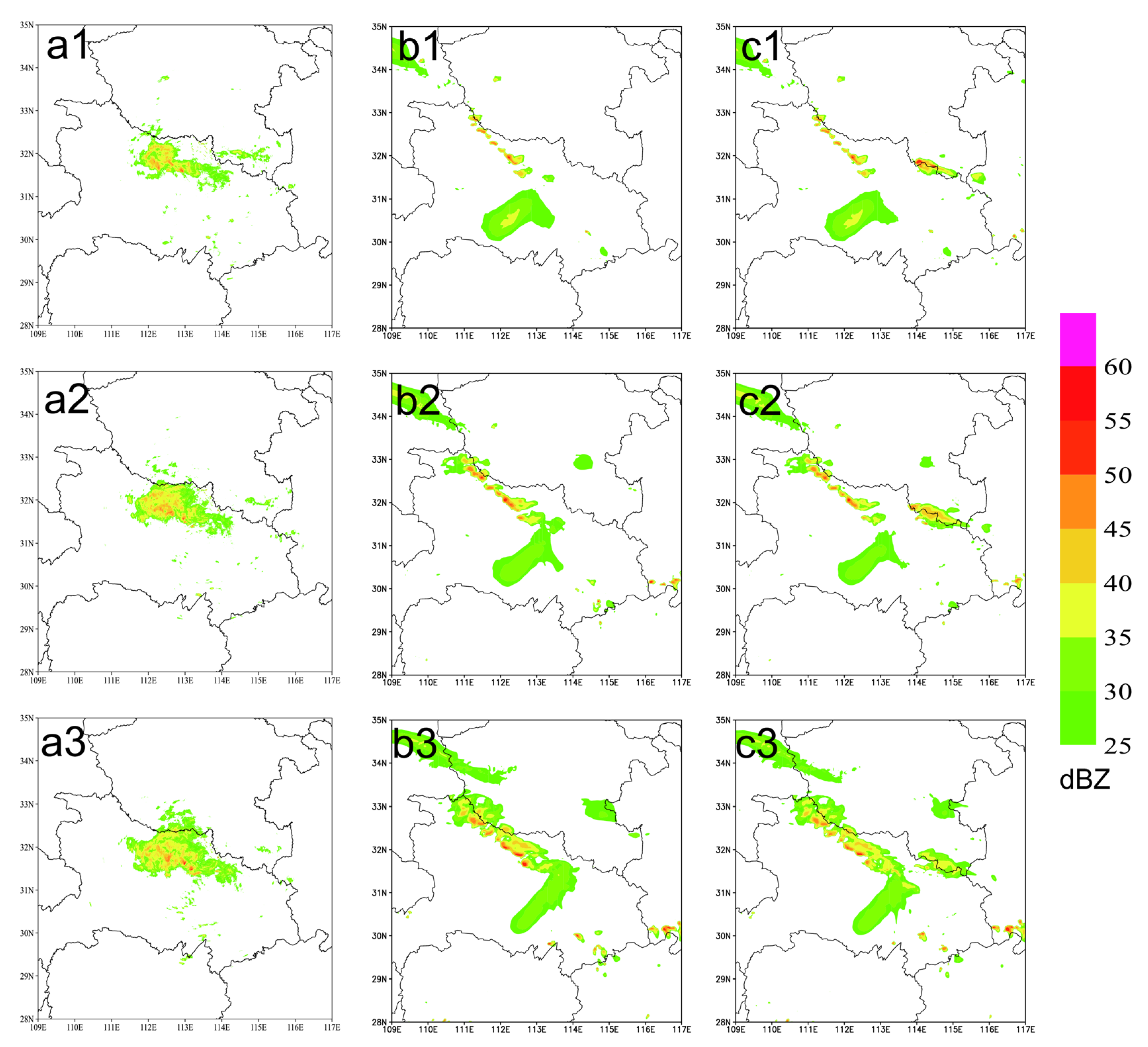

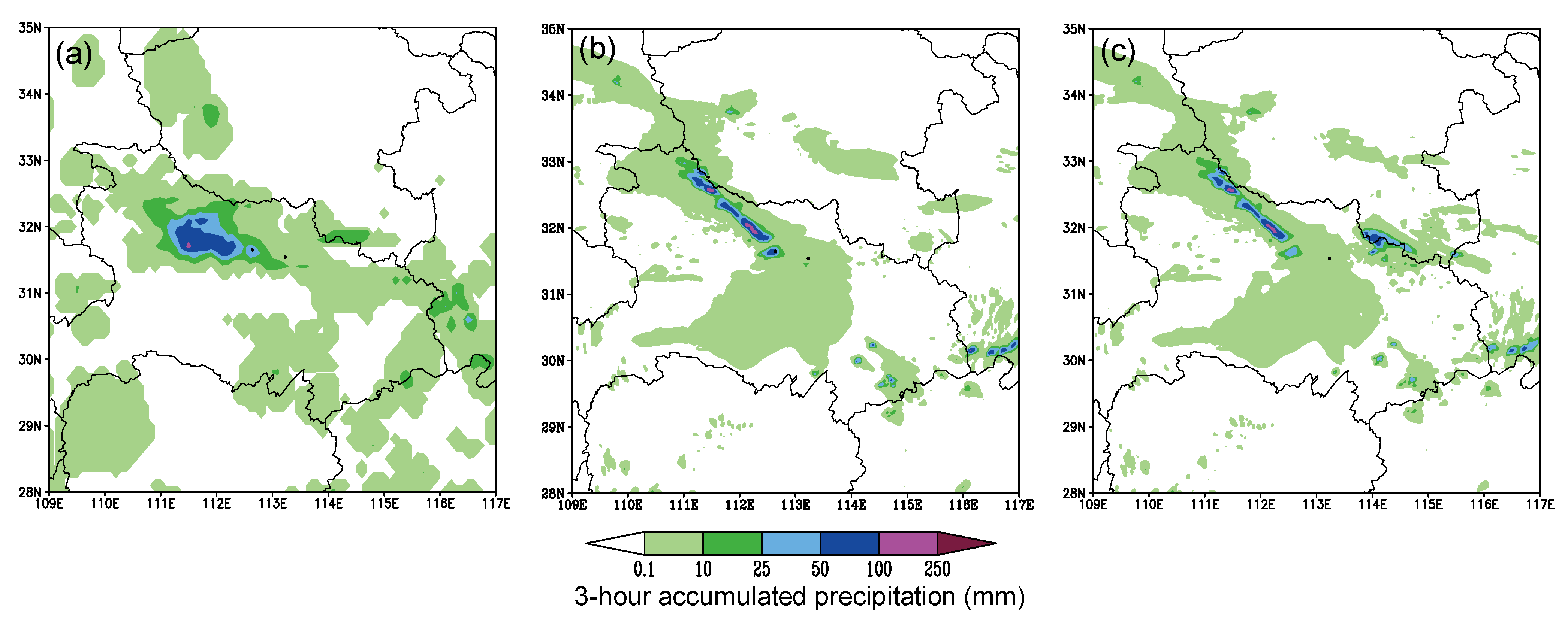
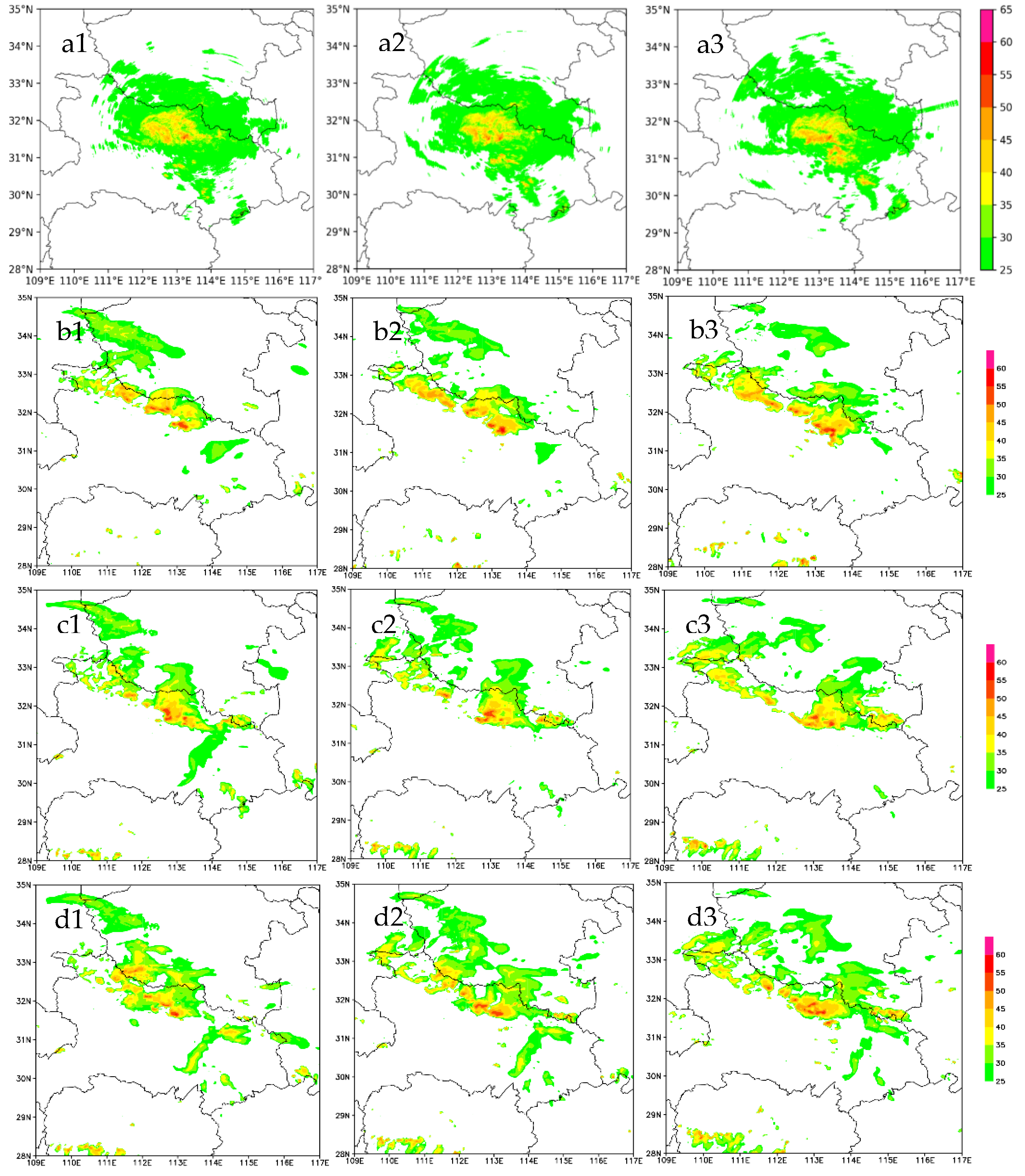

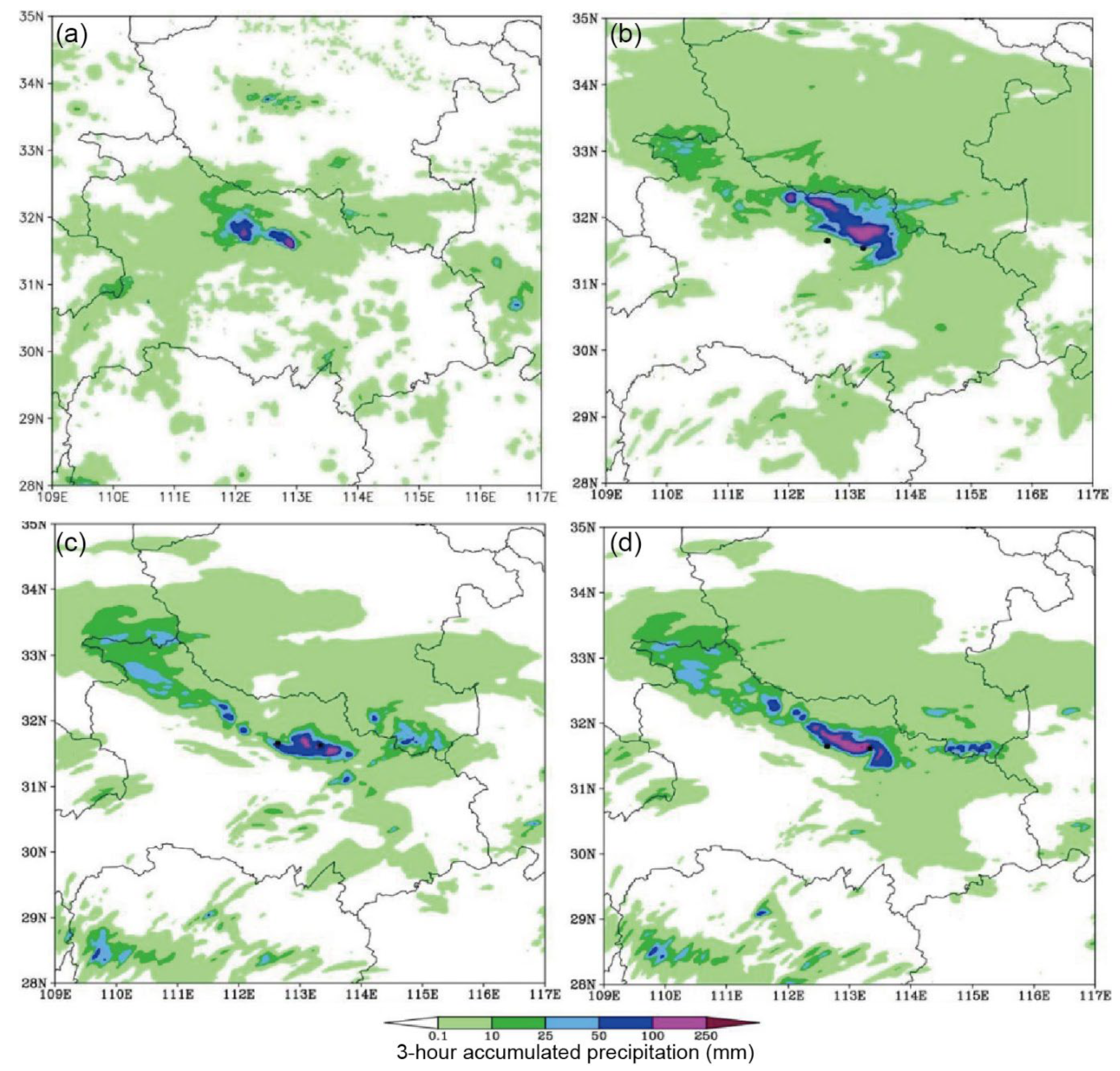
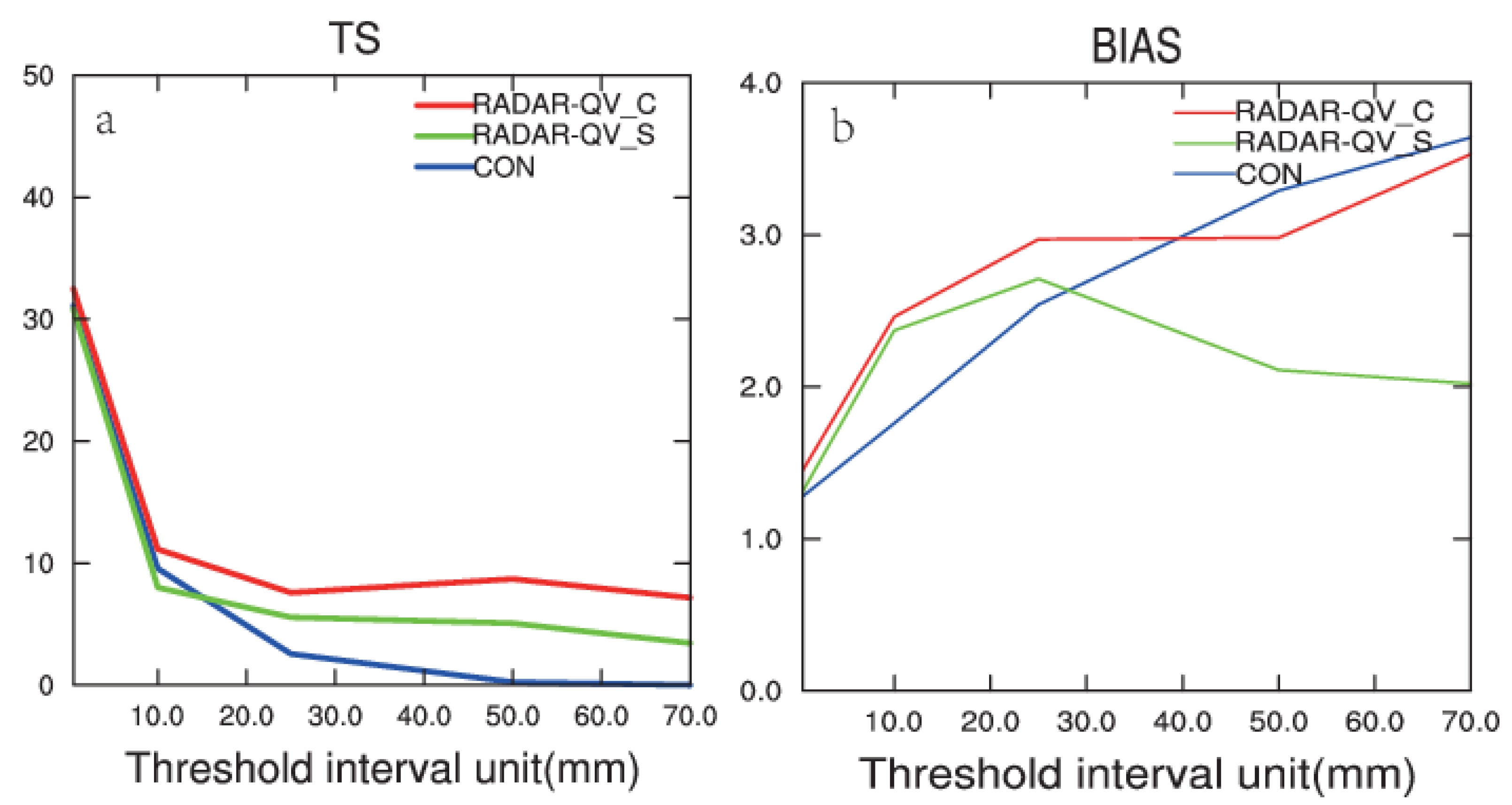
| Temperature | Z-RH Relationship Function |
|---|---|
| <5 °C | RH = 100, Z > 20 |
| ≥5 °C | RH = 83.7 + 0.28Z |
| Radar Name | Z9722 |
|---|---|
| Temporal resolution(min) | 6 |
| Grid dimensions (m) | 250 |
| Angular resolution (°) | 0.95 |
| Number of elevations | 9 |
| Lowest elevation (°) | 0.5 |
| Detection range(km) | 460 |
| Serial Number | Experiment | Experiment Scheme | Cycle |
|---|---|---|---|
| Exp1 | Control (CON) | No-radar data | No |
| Exp2 | RADAR-QV_S | Hydrometeor and water vapor retrieval; WRF | No |
| Exp3 | RADAR-QV_C | Hydrometeor and water vapor retrieval; WRF | Yes |
Disclaimer/Publisher’s Note: The statements, opinions and data contained in all publications are solely those of the individual author(s) and contributor(s) and not of MDPI and/or the editor(s). MDPI and/or the editor(s) disclaim responsibility for any injury to people or property resulting from any ideas, methods, instructions or products referred to in the content. |
© 2023 by the authors. Licensee MDPI, Basel, Switzerland. This article is an open access article distributed under the terms and conditions of the Creative Commons Attribution (CC BY) license (https://creativecommons.org/licenses/by/4.0/).
Share and Cite
He, Z.; Ye, J.; Li, Z.; Lin, C.; Song, L. Impacts of Radar Data Assimilation on the Forecast of “12.8” Extreme Rainstorm in Central China (2021). Atmosphere 2023, 14, 1722. https://doi.org/10.3390/atmos14121722
He Z, Ye J, Li Z, Lin C, Song L. Impacts of Radar Data Assimilation on the Forecast of “12.8” Extreme Rainstorm in Central China (2021). Atmosphere. 2023; 14(12):1722. https://doi.org/10.3390/atmos14121722
Chicago/Turabian StyleHe, Zhixin, Jinyin Ye, Zhijia Li, Chunze Lin, and Lixin Song. 2023. "Impacts of Radar Data Assimilation on the Forecast of “12.8” Extreme Rainstorm in Central China (2021)" Atmosphere 14, no. 12: 1722. https://doi.org/10.3390/atmos14121722
APA StyleHe, Z., Ye, J., Li, Z., Lin, C., & Song, L. (2023). Impacts of Radar Data Assimilation on the Forecast of “12.8” Extreme Rainstorm in Central China (2021). Atmosphere, 14(12), 1722. https://doi.org/10.3390/atmos14121722






